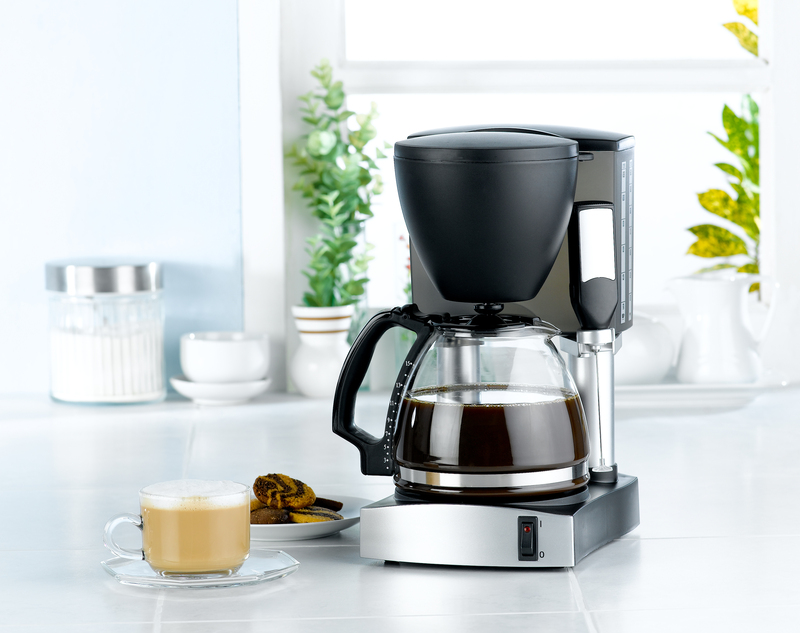Building Healthier Homes with Superior Air Quality
Posted on 19/09/2025
Building Healthier Homes with Superior Air Quality: A Comprehensive Guide
The health of your home isn't just about spotless counters or organized shelves--it hinges significantly on the air quality your family breathes every day. As modern homeowners become increasingly conscious about well-being, building healthier homes with superior air quality has moved to the forefront of home design and renovation priorities. This in-depth guide explores actionable strategies, expert advice, and the latest innovations to ensure that your home is a true sanctuary, brimming with fresh and healthy air.

Why Air Quality Matters for a Healthy Home
Many of us spend up to 90% of our lives indoors, making indoor air quality not just an environmental issue, but a critical health one. Poor air quality is linked with respiratory problems, allergies, headaches, and even long-term illnesses like asthma and cardiovascular disease. Thus, superior air quality in the home is directly tied to the overall wellness of its inhabitants.
Common Sources of Indoor Air Pollution
- Dust and Allergens: Carpets, upholstery, and bedding trap dust mites, pet dander, and pollen.
- Volatile Organic Compounds (VOCs): Paints, cleaning supplies, and synthetic building materials release gases that can be harmful when inhaled regularly.
- Cigarette Smoke: Lingering toxins from tobacco products pollute indoor air and stick to surfaces.
- Mold and Mildew: Damp and inadequately ventilated spaces encourage fungi growth, impacting air quality.
- Combustion By-Products: Stoves, fireplaces, and furnaces can emit harmful gases like carbon monoxide.
Key Features of a Home with Superior Air Quality
To design or retrofit a healthy home, it's essential to integrate technologies and practices that enhance air purity. Below, we discuss the most effective components of a home with excellent indoor air quality:
1. Proper Ventilation Systems
An effective ventilation system is the backbone of superior air quality at home. These systems perform the crucial task of exchanging polluted indoor air with fresh outdoor air.
- Mechanical Ventilation: Install energy recovery ventilators (ERVs) or heat recovery ventilators (HRVs) to continuously filter and replace indoor air. These systems are especially vital in well-sealed, energy-efficient homes.
- Natural Ventilation: Whenever possible, open windows and doors to allow a breeze to carry away indoor pollutants. Cross-ventilation designs harness wind to refresh interior spaces naturally.
- Exhaust Fans: Use exhaust fans in high-humidity areas like kitchens and bathrooms to remove contaminants and moisture.
2. Filtration Technologies
Air filtration is a powerful tool for removing dust, allergens, and small particles from indoor air.
- HEPA Filters: High-Efficiency Particulate Air (HEPA) filters capture up to 99.97% of airborne particles, including pollen, pet dander, and fine dust.
- Activated Carbon Filters: These filters adsorb odors and VOCs, making them ideal for combating chemical pollutants.
- UV Purification: Ultraviolet (UV-C) lights installed in air handling units can neutralize airborne bacteria, viruses, and mold spores, further boosting air quality.
3. Moisture Control
Mold and mildew flourish in damp environments, releasing spores and mycotoxins that degrade air quality and pose health risks. Managing humidity and promptly addressing leaks is paramount in building healthier homes.
- Dehumidifiers: Use in basements, laundry rooms, and other areas susceptible to dampness.
- Waterproofing: Ensure roofs and foundations are sealed against water intrusion.
- Prompt Repairs: Attend to plumbing leaks or spills immediately to prevent moisture accumulation.
4. Low-Emission Materials and Furnishings
Building and furnishing your home with low-emission or no-VOC materials greatly reduces exposure to harmful chemicals.
- Low-VOC Paints and Finishes: Opt for products clearly labeled as low- or zero-VOC to minimize off-gassing.
- Solid Wood and Natural Fibers: Choose natural flooring, cabinetry, and furniture made without synthetic adhesives.
- Formaldehyde-Free Materials: Select engineered woods, insulation, and cabinetry labeled as formaldehyde-free.
Best Practices for Ensuring Clean Air Indoors
It's not just about the construction or renovation phase--maintaining a home with superior air quality requires ongoing diligence. Here are some everyday practices to ensure your home remains a beacon of health:
- Regular Cleaning: Dust, vacuum (with HEPA filters), and wash textiles frequently to keep allergens and pollutants at bay.
- No Smoking Indoors: Make your home a strictly non-smoking environment.
- Indoor Plant Selection: Some houseplants can help filter air, but excessive damp soil may introduce mold, so strike a balance.
- Control Pet Dander: Bathe and groom pets regularly, and clean their bedding and play areas often.
- Replace Filters & Service Equipment: Change filters in HVAC systems as recommended by manufacturers to ensure optimal performance.
Modern Innovations for Superior Home Air Quality
With technological advancements, achieving cleaner indoor air has never been more attainable. The following innovations are revolutionizing healthy home air:
- Smart Air Quality Monitors: Modern devices continuously measure pollutants like PM2.5, CO2, VOCs, and humidity, alerting you when air quality dips.
- Automated Purifiers: Wi-Fi enabled air purifiers can adjust filtration settings based on real-time air quality data for precision cleaning.
- Low-Emission Insulation: Contemporary insulation materials not only keep your home comfortable but also ensure clean, safe air.
- Green Building Certifications: Organizations like LEED and WELL certify homes with strict standards for superior air quality and healthy living.
Designing a Healthier Home: Room-by-Room Strategies
Each room in your house faces unique challenges when it comes to air purity. Here's how to maximize superior indoor air quality throughout your living spaces:
1. Living Areas
- Keep floors, curtains, and upholstery clean to minimize dust buildup.
- Install an air purifier suited to the room size.
- Avoid candles or air fresheners that emit synthetic fragrances and chemicals.
2. Bedrooms
- Use hypoallergenic bedding and wash linens weekly in hot water.
- Keep windows open whenever weather permits to refresh the air.
- Ensure wardrobes and closets are dry to prevent mold growth.
3. Kitchen
- Rely on range hoods and exhaust fans while cooking to vent odorous fumes and moisture.
- Store chemicals and cleaning products in sealed, well-ventilated cabinets.
- Never use unvented gas stoves indoors.
4. Bathrooms
- Run exhaust fans during and after showers to remove humidity.
- Wipe down wet surfaces promptly to limit mold formation.
- Use non-toxic cleaning products.
5. Basements and Utility Rooms
- Monitor for leaks and waterproof where necessary.
- Install dehumidifiers if humidity routinely exceeds 50%.
- Maintain appliances like furnaces and water heaters for safe operation and leak prevention.
Expert Tips for Building and Retrofitting Homes for Optimal Air Quality
- Engage Air Quality Professionals: Consult with HVAC and building science experts when designing or renovating spaces to optimize healthy home environments from the ground up.
- Balance Airtightness with Ventilation: While tighter homes conserve energy, it's crucial to ensure they don't become "stale boxes"--always implement mechanical ventilation systems.
- Prioritize Natural Lighting: Adequate sunlight not only boosts mood but inhibits mold and mildew growth indoors.
- Monitor and Adjust Seasonally: Humidity and pollutant levels fluctuate with the seasons, so regularly evaluate and adjust your systems for optimal results.
Benefits of a Home with Superior Air Quality
The rewards of making air purity a priority extend well beyond simple comfort. Here's why home air quality improvement matters:
- Enhanced Health: Reduced incidence of respiratory illnesses, asthma, and allergies.
- Improved Focus and Sleep: Clean air decreases headaches, brain fog, and sleep disturbances.
- Long-Term Cost Savings: Less illness and fewer maintenance concerns as mold, pests, and pollutants are held at bay.
- Greater Property Value: Homes with documented superior air quality often fetch higher prices and attract discerning buyers.

Frequently Asked Questions About Building Healthier Homes
Can air purifiers alone guarantee superior air quality?
While air purifiers are powerful allies in reducing pollutants, achieving truly superior air quality at home requires a comprehensive approach. This includes proper ventilation, moisture control, and low-emission materials.
What are the most harmful indoor air pollutants?
Particles like PM2.5, VOCs, mold spores, pet dander, and combustion byproducts (carbon monoxide, nitrogen dioxide) are among the most troublesome for health. Ongoing monitoring and preventive strategies are vital.
How often should filters be changed?
HVAC and air purifier filters should generally be changed every 1-3 months, or as recommended by the manufacturer. High-use periods or pet-heavy homes may require more frequent changes.
Are natural cleaning products better for indoor air?
Yes, natural or eco-friendly cleaning products usually contain fewer harmful chemicals, reducing the risk of VOCs and other emissions in your living spaces.
Conclusion: Paving the Way for Healthier, Happier Homes
Building healthier homes with superior air quality is an investment in your family's long-term wellness and comfort. By understanding the causes of indoor pollution and integrating proven solutions in design, equipment, and daily habits, you can transform your living space into a haven of well-being. Modern innovations, coupled with mindful choices, make it easier than ever to enjoy pure, healthy air at home.
- Start small: Identify one or two improvements that can make an immediate impact.
- Consult professionals for full-home upgrades or renovations focused on air quality.
- Stay vigilant: Monitor your home's air and adapt your approach with seasonal changes.
With dedication, knowledge, and the right technologies, your journey to building a healthier home with exceptional indoor air quality will pay handsome dividends for years to come--a breath of fresh air your family will appreciate every single day.




